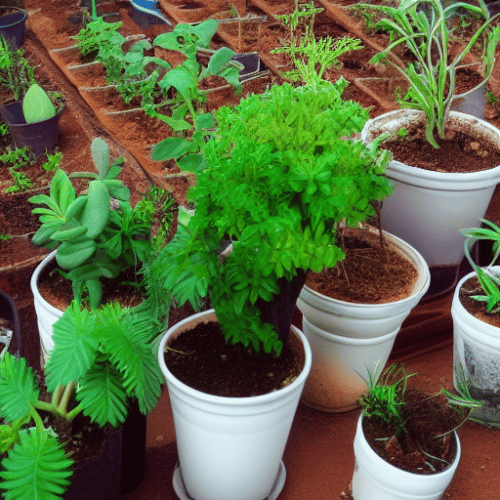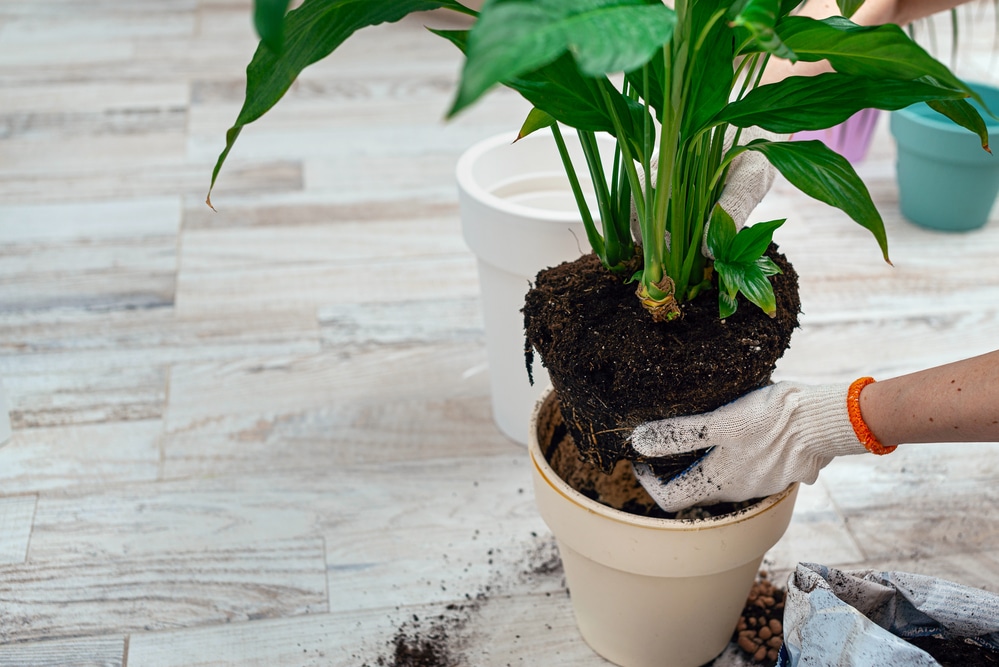Last Updated on
Are you wondering how to repot plants in a way that’s least stressful for them? Then you’ve come to the right place. We’ll guide you through a simple process of giving your potted plants a new home and some fresh soil to grow.
After a period of time, most plants will need to be moved to a new pot, especially as they get bigger and more robust. A small pot can inhibit your flowers and ferns from thriving and being healthy.
Sometimes, repotting a plant could even mean you don’t change the planter at all. You can use the same pot but add fresh soil to the mix to protect against root rot and improve the nutrition of your existing plant bedding. Today, we’re going to be looking at how you can safely move repotted plants into a new home, regardless of whether you’re looking to move your plant to a larger pot or whether you just want to add more soil.
When Should You Repot a Plant?
On average, plants need to be repotted every 12 to 18 months, depending on how actively they’re growing. While some slow-growing plants can survive for years in the same container, others will require more frequent soil replacement. The best way to determine when you should start repotting plants is to learn about your plant and, more specifically, its growth phases.
Find out how quickly the root ball of your plant is likely to grow, and pay attention to any spikes in growth that may determine when you need to move the plant to a new home. If you see one of the following signs, this is usually an indicator that you need to repot your leafy friend:
- Roots are beginning to grow through the pot’s drainage hole.
- The roots are growing out of the planter (common with larger plants).
- The plant isn’t growing as quickly as it should be during its growing season.
- The plant is very top-heavy, which may be causing the plant stem to bend.
- The parts of the plant above the top of the pot are very large
- There’s a notable mineral and salt build-up around the plant and planter.
How to Repot Plants
If you’ve just bought a new plant with its pot, you shouldn’t have to repot it straight away. However, we recommend that every new plant be checked for any of the above signs listed as indicators to make the change. Once you notice the plant actively growing bigger than its planter, you’ll need to switch it to a new home. For this, you need to start by choosing the right size pot for the plant.
You don’t want too much soil and space sitting around your plant, but you do want plenty of room for the roots to grow without them bursting through the bottom of the pot.
Start by removing your plant from the current pot to get an idea of the root ball size. You may need to carefully loosen the roots from the pot, depending on how much they’ve grown into the planter. In most cases, you can do this with your fingers, but you might need to use a sharp knife to remove any dead parts that have stuck onto the base of the pot. If your plants are root bound, you’ll need to give the roots a little trim before moving them into the new soil. But do be careful with trimming roots, as they could easily get infected, and your plant may then develop root rot.
Repotting: Moving the Plant to the New Pot

Put the current pot out of the way if you’re getting rid of it, or save it for another plant. If you’re using the same pot for a small plant but changing the soil, you’ll need to remove the old potting mix from within the planter, as well. The old soil can be put in compost, as most of the soil’s nutrients will have already been absorbed by the plant. Before adding new soil, ensure that the drainage hole isn’t clogged up and that any water can drain away easily.
You may not want to remove all of the old soil, but you should change at least a third. Add a layer of new potting soil when you’re ready, and pat it down to remove extra room and air pockets. If your planter doesn’t have an included hole at its base, make sure you layer the bottom with rocks or gravel before adding the potting mix so that the bottom of the planter doesn’t get too waterlogged. It will give the water somewhere to pool.
After you’ve added a few inches of new soil, you can set your plant carefully on the newly added mix. Don’t place too many plants in the same planter if you’re using a large pot. As you gently place your plant into position, don’t be afraid to get your hands dirty. Make sure the plants sit in the centre of the pots when you repot them. If they grow too close to the rim, this can make watering more difficult.
Add the remaining repotting mixture on top of the root ball for your plant, making sure it’s fully covered.
Can Plants Die From Repotting?
Repotting a plant can be a daunting experience for beginners. If you place the plant in the planter without the right preparation, you risk causing stress to the plant. Even just moving your plant and its roots into the same size pot can cause stress if you’re not careful. However, you can’t simply leave your plants in the same pot forever, as they won’t get enough nutrients.
The best way to protect your plants when it’s time to repot is to take precautions. When you drain and remove your plant from the old pot, don’t remove all the existing soil. It can help to reduce some of the shock and stress. Ensure your plants have the right moisture and nutrients when you fill the new pot with fresh soil, and keep an eye on the foliage.
After you cover the root ball with soil, it’s hard to keep track of how well they’re adjusting to the new pot. You can look at how much excess water comes out of the drainage holes. Too much water from the drainage holes might be a sign that the remaining roots of your indoor plants are struggling. It’s also worth watching top-heavy plants to see if they droop and checking on the colour of your plant’s leaves after adding new soil. Wilted and yellow leaves can indicate stress to plants.
Try to place the plant in the same position in your home after repotting it to reduce stress, and remember to offer the same lighting and heating conditions. Also, keep in mind that the plant will need some time to adapt to its new environment, so be patient.
Caring for Plants After Repotting
Giving your plant a new pot can be a fantastic way to ensure its roots have room to grow. Most plants will outgrow their pots over time, and repotting ensures they have the space they need to thrive. However, it’s essential to proceed with caution.
Choose the pots for your plant carefully, ensuring that not too much of the plant will hang over the rim of the pot. Think about the position of your houseplants when repotting houseplants and how much water they need when they are in the new pot. Many owners end up overwatering their houseplants when they move them into a larger container. It is because they think they need to cover the entire soil area with water.
Start Repotting Your Leafy Friends
Just like any gardening skill, learning how to move your plants to the right container is a great way to keep them healthy. Just take your time to learn what kind of nutrition you should fill the pot with, how you should approach the challenge of repotting, and whether you might need to trim some roots and leave the rest.
If you’re not used to indoor gardening and you haven’t tried a repot before, it’s crucial to keep a close eye on your plants when moving them to a bigger pot. A repot can be a stressful experience for any plant, even if you choose the nicest, most appropriate pots to fill. If your plants begin to show signs of illness or disease, look carefully for anything you can do to keep them in great condition. Perhaps some extra plant food would be useful in some cases.
Rebekah is a writer who loves to explore new products and find hacks that make life easier. She has a knack for all things home improvement, health and fitness. So you’ll often find her on Pinterest or browsing Houzz for ideas.
She’s always looking for the next thing to fix up around the house or what gadget might be just right for her lifestyle. Rebekah enjoys exploring new recipes, taking care of her family, and making sure she stays healthy with regular workouts at the gym.



